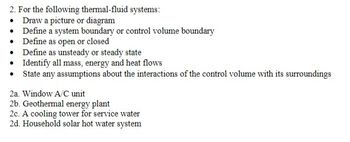
Elements Of Electromagnetics
7th Edition
ISBN: 9780190698614
Author: Sadiku, Matthew N. O.
Publisher: Oxford University Press
expand_more
expand_more
format_list_bulleted
Question

Transcribed Image Text:**Task for Thermal-Fluid Systems**
For each of the following thermal-fluid systems:
1. **Draw a Picture or Diagram**:
- Create a visual representation that accurately depicts the system being analyzed.
2. **Define a System Boundary or Control Volume Boundary**:
- Specify the limits of the system or the control volume within which the analysis will be conducted.
3. **Define as Open or Closed**:
- Determine if the system is open (allows mass transfer across boundaries) or closed (mass remains constant within the boundaries).
4. **Define as Unsteady or Steady State**:
- Identify whether the system operates in unsteady (changing with time) or steady state (remains constant over time).
5. **Identify All Mass, Energy, and Heat Flows**:
- Outline all exchanges of mass and energy, including heat transfer, that occur within the system.
6. **State Any Assumptions About the Interactions of the Control Volume with Its Surroundings**:
- Clearly state assumptions made regarding how the system interacts with the environment and surrounding systems.
**Systems to Analyze:**
2a. Window A/C Unit
2b. Geothermal Energy Plant
2c. Cooling Tower for Service Water
2d. Household Solar Hot Water System
Expert Solution
This question has been solved!
Explore an expertly crafted, step-by-step solution for a thorough understanding of key concepts.
This is a popular solution
Trending nowThis is a popular solution!
Step by stepSolved in 3 steps with 1 images

Knowledge Booster
Learn more about
Need a deep-dive on the concept behind this application? Look no further. Learn more about this topic, mechanical-engineering and related others by exploring similar questions and additional content below.Similar questions
- adv ctate An infinitely long cylindrical container has a cross section area of radius R, and is placed horizontally with gravity being in the -y direction, as shown in the figure. The cylinder is 50% filled with water (the shaded part), with density p. The other 50% of the volume in the cylinder is filled with air with constant pressure of p = Po. The length of the cylindrical container in the axial direction is W. R Use the surface integral method to compute the hydrostatic force acted on the 4th quadrant of the cylinder wall, as shown by the thickened line in the figure.arrow_forwardQ4/ A room on the second floor of a house with a balcony has a door. The door made of teak (wood) and it contains a large sheet of glass (outside winter type) in the middle and constitutes 80% of the area of the door. Door thickness is 40 mm and the temperature in the room 25. °C when the temperature is in the balcony 8 °C. Calculate the rate of heat loss from the room to the balcony through the door. The door dimensions 2m x 1m. Assume Inside and outside still air thermal resistance f= 8.29 W/m2 °C and f. 34.1 W/m2 °C respectivelyarrow_forward1. Temperatures are measured at the left-hand face and at a point 4 cm from the left-hand face of the planar wall shown in the figure below. These temperatures are T₁ = 45.3 °C and T* = 21.2 °C. The heat flow through the planar wall is steady and one dimensional. What is the value of T2 at the right-hand surface of the wall? TI T* 4 cm 10 cm T2arrow_forward
- i need help with this question all parts asaparrow_forwardi need help with this question all parts asaparrow_forwardGive an example of application of the Oth law of thermodynamics in everyday life. List explicitly Systems 1, 2, and 3 and what is the purpose of them being at the same temperature.arrow_forward
- 3.4 Estimate the rate of heat loss due to radiation from a covered pot of water at 95 ° C. How does this compare with the 60 W that is lost due only to convection and conduction losses? What amount of energy input would be needed to maintain the water at its boiling point for 30 minutes? The polished stainless steel pot is cylindrical, 20 cm in diameter and 14 cm high, with a tight-fitting flat cover. The air temperature in the kitchen is about 25 ° C. State any assumptions you make in deriving your estimatesarrow_forwardAs the temperature increases, the thermal conductivity of a gas... (A) increases (B) decreases (C) remains constant (D) increases up to a certain temperature and then decreasearrow_forwardHeat transferarrow_forward
arrow_back_ios
arrow_forward_ios
Recommended textbooks for you
 Elements Of ElectromagneticsMechanical EngineeringISBN:9780190698614Author:Sadiku, Matthew N. O.Publisher:Oxford University Press
Elements Of ElectromagneticsMechanical EngineeringISBN:9780190698614Author:Sadiku, Matthew N. O.Publisher:Oxford University Press Mechanics of Materials (10th Edition)Mechanical EngineeringISBN:9780134319650Author:Russell C. HibbelerPublisher:PEARSON
Mechanics of Materials (10th Edition)Mechanical EngineeringISBN:9780134319650Author:Russell C. HibbelerPublisher:PEARSON Thermodynamics: An Engineering ApproachMechanical EngineeringISBN:9781259822674Author:Yunus A. Cengel Dr., Michael A. BolesPublisher:McGraw-Hill Education
Thermodynamics: An Engineering ApproachMechanical EngineeringISBN:9781259822674Author:Yunus A. Cengel Dr., Michael A. BolesPublisher:McGraw-Hill Education Control Systems EngineeringMechanical EngineeringISBN:9781118170519Author:Norman S. NisePublisher:WILEY
Control Systems EngineeringMechanical EngineeringISBN:9781118170519Author:Norman S. NisePublisher:WILEY Mechanics of Materials (MindTap Course List)Mechanical EngineeringISBN:9781337093347Author:Barry J. Goodno, James M. GerePublisher:Cengage Learning
Mechanics of Materials (MindTap Course List)Mechanical EngineeringISBN:9781337093347Author:Barry J. Goodno, James M. GerePublisher:Cengage Learning Engineering Mechanics: StaticsMechanical EngineeringISBN:9781118807330Author:James L. Meriam, L. G. Kraige, J. N. BoltonPublisher:WILEY
Engineering Mechanics: StaticsMechanical EngineeringISBN:9781118807330Author:James L. Meriam, L. G. Kraige, J. N. BoltonPublisher:WILEY

Elements Of Electromagnetics
Mechanical Engineering
ISBN:9780190698614
Author:Sadiku, Matthew N. O.
Publisher:Oxford University Press

Mechanics of Materials (10th Edition)
Mechanical Engineering
ISBN:9780134319650
Author:Russell C. Hibbeler
Publisher:PEARSON

Thermodynamics: An Engineering Approach
Mechanical Engineering
ISBN:9781259822674
Author:Yunus A. Cengel Dr., Michael A. Boles
Publisher:McGraw-Hill Education

Control Systems Engineering
Mechanical Engineering
ISBN:9781118170519
Author:Norman S. Nise
Publisher:WILEY

Mechanics of Materials (MindTap Course List)
Mechanical Engineering
ISBN:9781337093347
Author:Barry J. Goodno, James M. Gere
Publisher:Cengage Learning

Engineering Mechanics: Statics
Mechanical Engineering
ISBN:9781118807330
Author:James L. Meriam, L. G. Kraige, J. N. Bolton
Publisher:WILEY